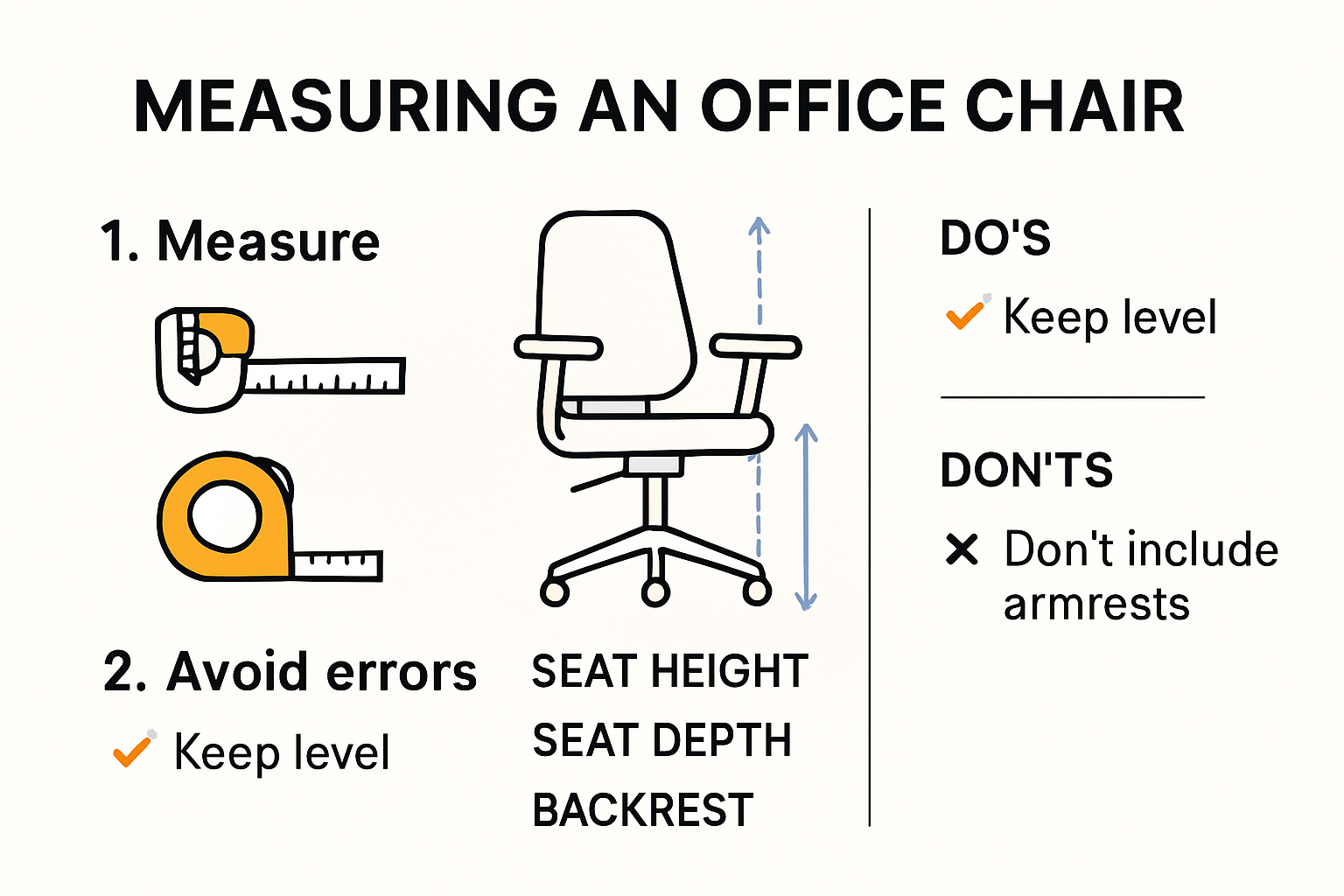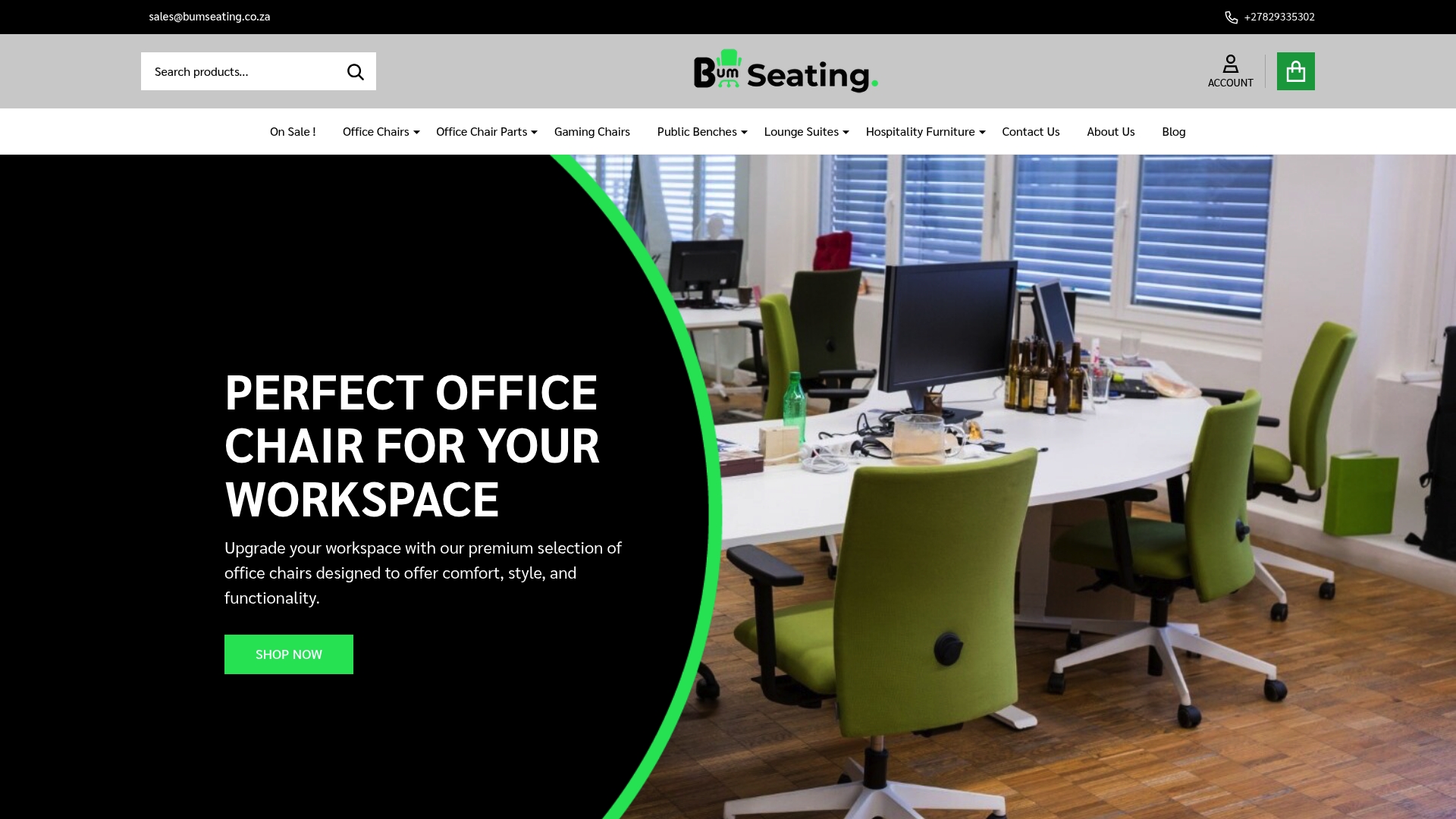How to Measure Office Chairs: Accurate Guide for 2025
30th Jul 2025
How to Measure Office Chairs: Accurate Guide for 2025

Measuring office chairs sounds simple enough and you might think any chair will do for your workspace. Yet, more than 30% of office workers report back pain linked to poorly fitted chairs. The shocker is this discomfort is mostly down to just one or two missed measurements that anyone can avoid with the right know-how.
Table of Contents
- Key Measurements For Office Chairs
- Step-By-Step Guide To Measuring Chairs
- Common Mistakes And How To Avoid Them
- Choosing The Best Size For Your Space
Quick Summary
| Takeaway | Explanation |
|---|---|
| Choose the right seat height | Ideal height is between 15 to 22 inches for proper foot placement and knee angle. |
| Consider seat depth for comfort | Depth should be 15 to 17 inches to support thighs without restricting circulation. |
| Measure backrest dimensions | Backrest should be 12-19 inches wide to fit the spine’s natural curve and support posture. |
| Avoid common measurement errors | Ensure seat size fits body proportions to prevent discomfort and musculoskeletal issues. |
| Select chairs for your workspace | Choose a chair that aligns with workspace dimensions to maximize comfort and efficiency. |
Key Measurements for Office Chairs
Selecting the right office chair requires precise measurements that ensure comfort, support, and ergonomic functionality. At Bum Seating, we understand that accurate chair dimensions are crucial for creating productive and comfortable workspaces.
Seat Height and Depth Fundamentals
Precision in seat measurements is critical for proper body alignment and workplace comfort. The Occupational Safety and Health Administration (OSHA) recommends specific guidelines for optimal chair dimensions. The standard seat height should range between 15 to 22 inches, allowing users to place their feet flat on the floor with knees at a 90-degree angle. Seat pan depth is equally important, typically measuring 15 to 17 inches to support the thighs without putting pressure on the back of the knees.
Key Seat Measurement Considerations:
- Height Range: 15-22 inches from floor
- Seat Pan Depth: 15-17 inches
- Seat Pan Width: Minimum 18 inches
Here’s a summary table of essential office chair measurements based on recommended guidelines:
| Measurement | Recommended Range | Purpose/Benefit |
|---|---|---|
| Seat Height | 15-22 inches | Allows feet flat on floor, knees at 90° angle |
| Seat Pan Depth | 15-17 inches | Supports thighs without knee pressure |
| Seat Pan Width | Minimum 18 inches | Ensures comfortable sitting space |
| Backrest Width | 12-19 inches | Fits spine’s curve, supports posture |
| Backrest Height | Adjustable | Accommodates different body types |
| Armrest Position (from front) | Set back 6 inches from front | For optimal arm placement & desk clearance |
Backrest and Support Measurements
Research from the National Institutes of Health (NIH) emphasizes the importance of proper backrest measurements. An ideal backrest should be 12-19 inches wide, providing comprehensive support for the natural curve of the spine. The height should be adjustable to accommodate different body types, with specific attention to lumbar support positioning. This critical measurement helps prevent lower back strain and promotes better posture throughout the workday.
Comprehensive Chair Dimension Assessment
Beyond basic measurements, comprehensive chair fitting requires a holistic approach. The University of California, Davis ergonomics guidelines recommend considering additional factors such as armrest height, seat tilt mechanism, and overall chair width. Professional measurement involves checking not just individual components but how they work together to support the user.
For those interested in exploring more about office chair features, check out our detailed guide on office chair ergonomics.
Remember, the perfect office chair is more than just numbers – it’s about creating a comfortable, supportive environment that enhances productivity and well-being. At Bum Seating, we’re committed to helping you find the ideal seating solution that meets your unique needs.
Call to Action: Visit our showroom or explore our online collection to find the perfectly measured office chair that transforms your workspace comfort!
Step-by-Step Guide to Measuring Chairs
Measuring an office chair accurately requires precision and a systematic approach. At Bum Seating, we understand that proper chair measurement is essential for creating a comfortable and ergonomic workspace.
Preparing for Accurate Measurements
According to the Canadian Centre for Occupational Health and Safety, the first step in measuring an office chair involves gathering the right tools. You will need a flexible measuring tape, a notepad, and a flat surface for recording measurements. Begin by clearing the area around the chair and ensuring it is in its standard upright position. Remove any additional cushions or accessories that might interfere with precise measurements.
Essential Measurement Preparation:
- Measuring Tools: Flexible measuring tape
- Surface: Flat, stable ground
- Chair Position: Upright and unobstructed
The following table organises the step-by-step preparation process for accurate office chair measurement:
| Preparation Step | Details/Instructions |
|---|---|
| Gather Tools | Flexible measuring tape, notepad |
| Prepare Surface | Flat, stable ground for placing and measuring the chair |
| Position Chair | Set chair upright; remove any extra cushions or accessories |
| Clear Area | Ensure unobstructed access to all measurement points |
| Record Measurements | Use notepad to document each dimension measured |
Key Measurement Points
The University of California, Davis ergonomics guidelines recommend focusing on specific measurement points. Start with seat height, measuring from the floor to the top of the seat cushion. Next, measure seat width and depth, ensuring adequate space for comfortable sitting. The backrest requires careful measurement of height and width, paying special attention to lumbar support positioning.
Comprehensive Chair Dimension Assessment
The Occupational Safety and Health Administration’s purchasing guide emphasizes the importance of comprehensive chair measurement. Beyond basic dimensions, consider measuring armrest height, seat tilt mechanism, and overall chair width. Professional measurement involves understanding how individual components work together to support the user.
For those interested in exploring more about office chair ergonomics, check out our comprehensive guide to office chair features.
Remember, accurate chair measurement is about creating a personalized seating experience that promotes comfort and productivity. At Bum Seating, we are committed to helping you find the perfect chair that meets your unique needs.
Call to Action: Visit our showroom or explore our online collection to discover office chairs that are precisely measured for your comfort!

Common Mistakes and How to Avoid Them
Navigating the complex world of office chair measurements can be challenging. At Bum Seating, we understand that selecting the right chair involves more than just aesthetic considerations – it requires careful attention to ergonomic details and potential pitfalls.
Seat Size and Fit Misconceptions
The University of Rochester’s Environmental Health & Safety department warns that one of the most critical mistakes is choosing a chair without considering individual body proportions. A seat that is too wide or too narrow can lead to significant discomfort and potential musculoskeletal issues. Many people mistakenly select chairs based on appearance rather than fit, overlooking crucial measurement considerations.
Key Fitting Mistakes to Avoid:
- Incorrect Seat Width: Seats that are too wide or narrow
- Ignoring Personal Body Proportions: One-size-fits-all approach
- Overlooking Adjustability: Fixed position chairs
To help you quickly identify common office chair selection mistakes and their consequences, review this summary table:
| Mistake Type | Example/Description | Potential Consequence |
|---|---|---|
| Incorrect Seat Width | Chair too wide/narrow for user | Discomfort, poor support |
| Ignoring Body Proportions | Choosing “one-size-fits-all” | Musculoskeletal issues, poor posture |
| Overlooking Adjustability | Fixed position (non-adjustable) chairs | Lack of flexibility, limited comfort |
| Improper Seat Height | Seat too high/low for user | Unnatural posture, physical strain |
| Inadequate Seat Depth | Insufficient/thighs not supported | Reduced circulation, discomfort |
Height and Posture Errors
The Occupational Safety and Health Administration (OSHA) highlights critical errors in chair height selection that can compromise workplace comfort and health. Improperly adjusted seat height can force users into unnatural postures, leading to significant physical strain. Users often make the mistake of setting chair height without considering the relationship between seat position, knee angle, and foot placement.
Depth and Support Challenges
The University of Massachusetts Lowell’s Environmental Health and Safety department provides insights into the nuanced challenges of seat pan depth. A common mistake is selecting a chair without properly assessing seat pan depth in relation to individual body dimensions. The recommended approach involves ensuring that thighs are properly supported with approximately two finger-widths of clearance behind the knees.
For those seeking more detailed guidance, explore our comprehensive guide to office chair features.
At Bum Seating, we recognize that avoiding these common measurement mistakes is crucial for creating a comfortable and productive workspace. Our commitment goes beyond selling chairs – we aim to educate and support our customers in making informed seating choices.
Call to Action: Don’t settle for an uncomfortable chair! Visit our showroom or browse our online collection to find the perfectly measured office chair that supports your unique needs.
Choosing the Best Size for Your Space
Selecting the right office chair involves more than just personal comfort – it requires careful consideration of your workspace’s unique dimensions and functional requirements. At Bum Seating, we understand that the perfect chair is a harmonious blend of individual ergonomics and spatial constraints.
Workspace Dimension Considerations

Western University’s ergonomic guidelines provide critical insights into selecting a chair that fits both your body and workspace. The recommended seat height range of 15 to 21 inches allows flexibility for different user heights, while ensuring proper alignment with desks and workstations. Seat width recommendations start at a minimum of 18 inches, providing adequate support without overwhelming smaller work areas.
Space Optimization Factors:
- Seat Height Flexibility: 15-21 inches adjustable range
- Minimum Seat Width: 18 inches
- Backrest Height: Minimum 18 inches
- Armrest Positioning: Set back 6 inches from seat front
Ergonomic Fit and Spatial Constraints
The University of Pittsburgh’s Office of Public Safety & Emergency Management emphasizes the importance of chair selection that balances personal comfort with spatial limitations. A well-chosen chair should provide at least a 0.5-inch gap between the seat’s front edge and the back of the knees, ensuring proper circulation and comfort. This becomes particularly crucial in compact office environments where every centimetre of space matters.
Strategic Chair Selection for Different Spaces
Different workspace configurations demand unique chair sizing strategies. Home offices might require more compact designs, while corporate environments could accommodate larger, more elaborate seating solutions. Consider factors like mobility requirements, desk height, and the potential need for additional accessories such as wheeled bases or swivel mechanisms.
For those looking to dive deeper into office furniture planning, explore our comprehensive guide to smart space design.
At Bum Seating, we recognize that choosing the right chair is an investment in comfort, productivity, and overall workplace well-being. Our expert team is dedicated to helping you navigate the nuanced world of office chair selection, ensuring you find the perfect fit for both your body and your space.
Call to Action: Transform your workspace today! Visit our showroom or browse our online collection to discover office chairs that seamlessly blend comfort, ergonomics, and spatial intelligence.
Frequently Asked Questions
What are the key measurements to consider when measuring an office chair?
Key measurements to consider when measuring an office chair include seat height (15-22 inches), seat depth (15-17 inches), seat width (minimum 18 inches), backrest width (12-19 inches), and adjustable backrest height for proper lumbar support.
How do I measure the seat height of an office chair?
To measure the seat height, use a flexible measuring tape and measure from the floor to the top of the seat cushion while the chair is in its upright position. Ensure your feet can rest flat on the ground for proper ergonomics.
What is the recommended seat depth for optimal comfort?
The recommended seat depth is between 15 to 17 inches. This measurement helps support the thighs without restricting circulation, promoting better comfort during extended periods of sitting.
Why is measuring an office chair important for my health?
Measuring an office chair accurately is crucial for ensuring proper body alignment, reducing the risk of discomfort, and preventing musculoskeletal issues. A well-fitted chair can enhance productivity and overall workplace well-being.
Find Your Perfect Fit with Bum Seating – Shop Smarter, Sit Better
Have you ever measured your chair, only to realise it still falls short of real comfort? Many people make the mistake of overlooking seat height, depth, and backrest support, leading to back pain and poor productivity. As highlighted in our accurate guide for 2025, the right office chair is about more than just dimensions – it is about creating a healthier, more productive workspace. At Bum Seating, we know that choosing the right fit and ergonomic support changes how you work every day.

Do not settle for discomfort another day. Visit Bum Seating to explore our full range of modern, ergonomic office chairs – all designed to match the exact measurements and ergonomic needs you have just learned about. See clear photos, compare features, and buy the chair that finally fits your body and your space. Take control of your workspace comfort now and experience the difference proper measurement can make.
